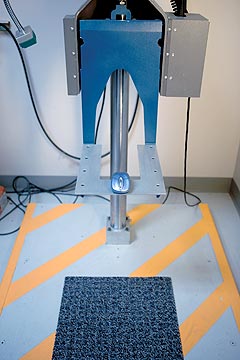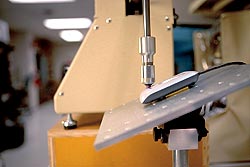REDMOND, Wash., March 22, 2005 — Have you ever braced yourself in that brief instance when you realize your cell phone is falling helplessly to the unforgiving pavement below? Have you experienced the frustration of reading those fateful words, “printer error”? It is in moments like these that we fully grasp the importance of reliability in the products we trust to get us through our days.

Pavan Davuluri, Reliability and Component Testing Lead, Microsoft Hardware
The Microsoft Hardware division has long recognized the importance of reliable products to consumers and businesses. A decade ago, the company hired its first internal reliability engineer and set up in-house testing facilities to ensure its products are of the utmost quality. Since then the reliability team has grown to five engineers, who work closely with Microsoft Hardware’s internal industrial designers, ergonomists and user-research groups to develop mice and keyboards that can withstand the most extreme conditions.
Pavan Davuluri is the Reliability and Component Lead at Microsoft Hardware. On this, the 10th anniversary of the Hardware labs, PressPass grabbed its lab coat and goggles, and spoke with Davuluri to get a behind-the-scenes look at the team’s testing labs.
Press Pass: First off, why has Microsoft Hardware chosen to highlight the work done in its testing labs?
Davuluri: This year marks the 10th anniversary of the labs at Microsoft Hardware and we are proud to be highlighting our work as we believe it sets us apart from our competitors. Everything our testing engineers have done to this point is based around a promise to provide our customers with quality products that run on industry-leading technology. We keep this promise by making sure every one of our mouse and keyboard products are tested for the gamut of possible user scenarios for the life of the product.
PressPass: What does Microsoft Hardware do differently in reliability testing?
Davuluri: Unlike many other peripheral manufacturers, our team of test engineers is a part of product development from the very beginning, rather than just at the end. We also have the luxury of working directly with Microsoft design, usability and ergonomics teams to look closely at how our customers are using their mice and keyboards in the real world. Each team shares its research and, from there, product ideas are developed and tested.

Drop test: Microsoft Hardware test tools drop mice onto carpet-covered steel.
Press Pass: Where does the testing take place? In an actual lab?
Davuluri: Our testing takes place in our labs as well as at manufacturing locations and beyond. The majority of our work is done in our research and development labs right here at Microsoft Hardware in Redmond, Washington. While we actually have several state-of-the-art labs under the same roof here in Redmond, we are not limited to Northwest environment and conditions. With the flick of a switch, our labs can mimic the harshest conditions on earth — from the dense heat of the Amazon to the deep freeze of Antarctica.
Press Pass: What are some of the steps that go into testing a Microsoft mouse or keyboard?
Davuluri: Our first test occurs before product prototypes are even available. Using computer-aided engineering (CAE) simulations we can perform virtual tests and understand product performance in specific user scenarios. This means we can drop a virtual mouse from a virtual desk onto virtual concrete and see exactly where a problem might occur.
After these CAE tests, every mouse and keyboard product is subjected to torment in 24 different tests that impose physical, chemical, mechanical and other environmental stresses — including extreme temperatures, humidity, chemicals, mechanical, vibration and shock.
Press Pass: You mentioned there are 24 tests. Can you share any specifics?
Davuluri: All Microsoft mice and keyboards are 100-percent tested. Some specific tests our products are subjected to include:
-
Type test: Each keyboard product is required to pass millions of cycles of key pressing — more typing than a typical person does in a lifetime — while maintaining superior performance.
-
Drop test: Keyboards are dropped up to 10 times from nearly three feet (.9 m); mice are dropped from more than three feet onto quarter-inch (6.4 mm) carpet covering steel and concrete.
-
Track test: During unique wear trials, mice are “run” between 85 and 215 miles (137 – 346 km) to test performance. That distance is comparable to traveling from London to Paris.
-
Touch test: The durability of mice and keyboards is tested in multiple scenarios simulating contact with common chemicals including hand lotion and sweat.
These are just a handful in the series of stringent tests that Microsoft mice and keyboards undergo to earn a Microsoft Hardware lab-approved seal before hitting store shelves.
Press Pass: Why is it important to test these products so harshly?

Abrasion test: Microsoft Hardware tests mice for abrasion durability.
Davuluri: Reliability is becoming increasingly important to our customers as they are using computers more often and in more ways than ever before. Communications stop if a cell phone breaks or a keyboard seizes up. In fact, we recently found out that nearly one in four employees has had to leave work because of broken computer equipment. Also, two-thirds of U.S. office workers told us they perceive repairing a broken mouse or keyboard to be more difficult than repairing a flat tire. Simply put, people need their devices to do one thing — work.
PressPass: What can we expect to see in the future from Microsoft Hardware?
Davuluri: As computers have become a significant and essential part of everyday life, Microsoft Hardware’s vision for its hardware has evolved. Today, the division is focused on providing comfortable devices that open up new possibilities for people to have fun and be productive while using their computer. Mice will be dropped from desks and liquids will be spilled on keyboards. It is our goal to make sure these products continue to withstand the demands of our customers, whether intentional or not. We are committed to developing and testing products that do what we say they will and look forward to another 10 years of success.




